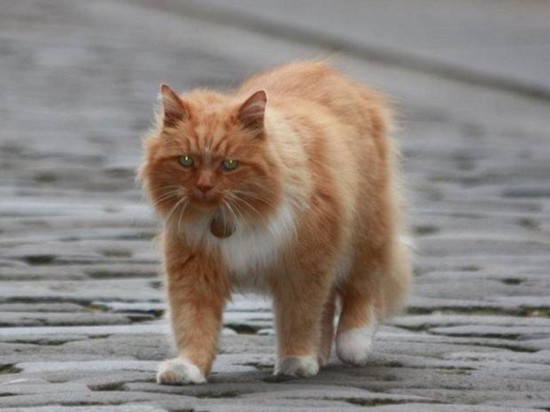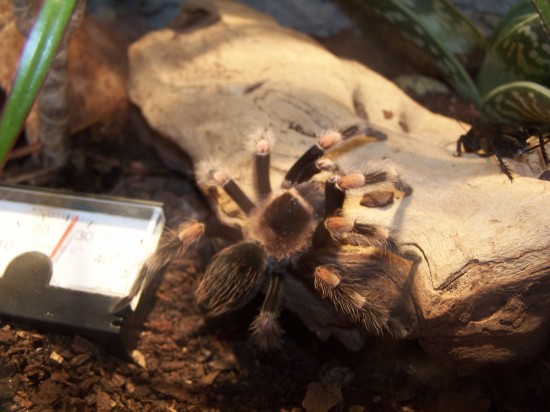

There are numerous cats who are famous in their own right, rather than simply because they are owned by celebrities. Some are enjoying internet stardom such as Grumpy Cat (famous for her typically dour but cute expression) and Colonel Meow (who also held the Guinness world record for the longest feline fur; although he sadly passed away this year). There are many famous fictional cats who have featured in cartoons (including Tom, Felix and Garfield), films (including Si and Am, the sneaky, Siamese cats belonging to Aunt Sarah in “Lady & the Tramp”) and books (including the Cheshire Cat in “Alice in Wonderland”). This little article covers some famous real cats, all of which have an interesting life story.
Hamish McHamish was a long haired, ginger tom who lived in St Andrews, Scotland. He was owned by Marianne Baird who looked after his veterinary needs such as vaccination and medical treatment when required, but he preferred to lead a nomadic life-style frequenting various different homes and businesses. Everyone loved Hamish, and he would always be guaranteed a warm welcome, food and water. Tourists would seek him out to meet him and have a photo taken with him. Hamish had a big social media following with his own Facebook page and Twitter account set up by his fans. His fame escalated as a result of an appearance on the BBC’s “The One Show”, publication of the book “Hamish McHamish of St Andrews: Cool Cat About Town” by Susan McMullan and numerous features in newspapers and magazines. Sadly, Hamish died of a chest infection in September this year, but his legacy lives on through his book and his bronze statue by David Annand, which was erected in Logies Lane, St Andrews.
Bob was another ginger tom who enjoyed a nomadic lifestyle. A London Busker called James Bowen found the injured cat in the hall of his sheltered accommodation block in Tottenham. He made enquiries amongst his neighbours to try to find the owner, but was unsuccessful. He therefore took Bob to the vet’s for much needed treatment, and continued to look for the owner. James wasn’t planning on getting a cat, but Bob decided he liked James very much and started to follow him everywhere; even travelling on the bus with him. As an owner never came forward, James and Bob soon became inseparable, and James credits Bob with helping him to overcome his drug addiction. The people of Covent Garden and Piccadilly (where James busked) soon came to enjoy seeing Bob out with James and would take photos and videos. Many of the videos appeared on YouTube. The Islington Tribune published James’ and Bob’s story, and this came to the attention of literary agent, Mary Pachnos. She introduced James to an author called Garry Jenkins, and together the pair wrote the book “A Street Cat Named Bob: And How He Saved My Life”, which was published in 2012. More books followed; a sequel called “The World According to Bob”, a children’s book called “Bob: No Ordinary Cat”, a picture book called “Where in the World is Bob?” and another children’s book called “My Name is Bob”.
“A Gift From Bob” is due to be published this October. This story covers James’ and Bob’s final Christmas on the streets together. If the story of Bob has touched you, why not join over a quarter of a million fans at the Facebook page “James Bowen & Street Cat Bob”.
Little Nicky is famous for a very different reason. He was the first commercial cat clone, and also one of the most expensive cats in the world; costing $50,000. Cloning is highly controversial, and his Texan owner is only known by her first name, Julie. Little Nicky was produced from the DNA of 19 year old Nicky (who died in 2003), a Maine Coon. The cloning was undertaken by a Californian Company called “Genetic Savings & Clonings” which closed in 2006. Researchers used technology known as chromatin transfer, where Nicky's DNA was transplanted into an egg cell whose nucleus had been removed. The embryo was then placed in the womb of a surrogate mother to produce Little Nicky. The highly risky process has angered welfare societies who felt that the money could have been better spent caring for the many cats in rescue organisations.
Simon sadly lived a very short life and died at the estimated age of two years in 1949. He was found in the dockyards of Hong Kong by 17 year old Ordinary Seaman George Hickinbottom, who was a member of the crew of the British frigate HMS Amethyst. Simon was undernourished, and George decided to smuggle him on board the ship. Simon soon earned his keep by keeping rats at bay, and became so popular with the crew that they soon considered him their lucky mascot. Simon unfortunately was not so lucky himself, and he was seriously injured by Chinese Communist gunfire during the Yangtze incident. Lieutenant Commander Skinner died as a result of this attack, and poor Simon never fully recovered from his wounds and developed a viral infection whilst in quarantine back in the UK that ultimately proved fatal. Simon was awarded the Animal Victoria Cross, the Dickin Medal, a Blue Cross medal and the Amethyst campaign medal. He was also lauded as “Able Seacat”. His burial at the PDSA Animal Cemetery in Ilford was attended by hundreds of people including the survivors of HMS Amethyst.
Tama was a career cat. She was famous for her position as station master at Kishi station in Japan. Her usual role came about in 2006 as a result of railway officials who had given Tama’s owner Toshiko Koyama the job of station manager. Tama was a tortoiseshell stray cat that lived near the station who was adopted by Toshiko, and officials felt that a feline greeter would be good for business. They were right, and her appointment led to a 17% increase in passengers in her first month. She was promoted to “super station master” in 2008, and received her own office (complete with litter tray) in addition to her station master’s hat and salary - which was paid in cat food! A further promotion in 2010 saw her become “operating officer”, and the first feline executive of a railroad corporation! She had two feline staff; her mother Miiko (deceased) and cat called Chibi who is still alive. Tama died in 1999 aged 15. She is remembered through her role in a documentary about cats called “La Voie du Chat” in French and “Katzenlektionen” in German. It was made by an Italian film-maker called Myriam Tonelotto, and broadcast in April 2009. Tama has also had a train named after her (“Tama Densha”) by the Wakayama Electric Railway in 2009, and in August 2010, the station building at Kishi was rebuilt with a new structure resembling a cat's face.
 How To Keep Dogs Safe Around Horses When Out On A Walk
How To Keep Dogs Safe Around Horses When Out On A Walk
 An Introduction To Some Popular Scent Hound Breeds
An Introduction To Some Popular Scent Hound Breeds
 Kerry Blue Terrier Hereditary Health And Average Longevity
Kerry Blue Terrier Hereditary Health And Average Longevity
 The Language Of Paws - How Dogs Use Their Paws To Communicate
The Language Of Paws - How Dogs Use Their Paws To Communicate
 How To Tell If Your Dog Has Dental Problems
How To Tell If Your Dog Has Dental Problems
 Positive Steps To Safeguarding Your Dog From Being Stolen
Positive Steps To Safeguarding Your Dog From Being Stolen
 Saint Bernard Dog Hereditary Health And Health Testing
Saint Bernard Dog
Saint Bernard Dog Hereditary Health And Health Testing
Saint Bernard Dog
 All About Tarantula Feeding
All About Tarantu
All About Tarantula Feeding
All About Tarantu
 Can Your Dog Swim? Why Some Dog Breeds Cant Swim
Can Your Dog Swim
Can Your Dog Swim? Why Some Dog Breeds Cant Swim
Can Your Dog Swim
 The Delightful And Tiny Japanese Terrier
The Delightful An
The Delightful And Tiny Japanese Terrier
The Delightful An
 Get Effective Equine Food Supplements Online
Get Effective Equine Food Supplements Online
G
Get Effective Equine Food Supplements Online
Get Effective Equine Food Supplements Online
G
Copyright © 2005-2016 Pet Information All Rights Reserved
Contact us: www162date@outlook.com